EMPLOYMENT IN THE MARKET ECONOMY IN ... - Eurostat - Europa
EMPLOYMENT IN THE MARKET ECONOMY IN ... - Eurostat - Europa
EMPLOYMENT IN THE MARKET ECONOMY IN ... - Eurostat - Europa
You also want an ePaper? Increase the reach of your titles
YUMPU automatically turns print PDFs into web optimized ePapers that Google loves.
Methodological notes<br />
The data used for the analysis in this publication come mainly<br />
from the Structural Business Statistics (SBS) compiled by<br />
<strong>Eurostat</strong>. These are supplemented by data from the Labour<br />
Cost Survey (LCS) on average hours worked where SBS data<br />
are missing (essentially in market services).<br />
The analysis contains several comparisons between different<br />
sources of data. In the first chapter a comparison is<br />
made of the SBS data on hours worked with data from the<br />
LCS and with estimates made from the EU Labour Force<br />
Survey (LFS). In the introductory chapter, data on total<br />
employed from the SBS are compared with data from the<br />
LFS. In the third chapter, SBS labour cost data are compared<br />
with LCS data. These three sources are described<br />
in turn below.<br />
Structural Business Statistics (SBS)<br />
Annual survey collected within the framework of Council<br />
regulation on structural business statistics (Regulation<br />
(EC, EURATOM) No. 58/97 of December 1996. The SBS<br />
Regulation governs the transmission of data to <strong>Eurostat</strong><br />
from the reference year 1995 onwards and, in principle,<br />
covers all market activities in sections C to K and M to O of<br />
NACE Rev. 1, but, in practice, the data available are confined<br />
to NACE Rev. 1 sections C to K, excluding section J,<br />
financial services. For further information, visit:<br />
http://forum.europa.eu.int/Public/irc/dsis/bmethods/<br />
info/data/new/main_en.html<br />
More precisely, within the SBS, the data used in the Introduction,<br />
in Chapter 1 on employment, value-added, investment<br />
and hours of work and in Chapter 3 on labour<br />
costs are taken from:<br />
series which covers all enterprises from 1995<br />
onwards (though the data are less complete and less accurate<br />
for the years before 1999). The data available for Greece<br />
cover only enterprises with 20 persons or more employed<br />
and are, therefore, not included in the series. Data on total<br />
persons employed are not available for Poland and Slovenia<br />
because of missing data on self-employed in these two countries.<br />
In the analysis of employment, the number of employees<br />
has therefore been used instead. Data for Hungary do<br />
not cover enterprises with less than 5 persons employed and<br />
the coverage of small enterprises is also incomplete for<br />
Slovakia.<br />
The data used in Chapter 2 on employment and<br />
value-added per person employed by size of enterprise<br />
are taken from:<br />
series, which covers enterprises<br />
whose main activity is in industry (NACE Rev. 1.<br />
sections C to F) or in market services (NACE Rev. 1. sections<br />
G to K excluding section J) and which breaks data<br />
down by the employment-size of enterprise. In the analysis,<br />
these data are grouped into four size classes, micro<br />
enterprises with 1-9 persons employed, small enterprises<br />
with 10-49 persons employed, medium-sized enterprises<br />
with 50-249 persons employed and large enterprises with<br />
250 or more persons employed. Data for Poland refer to<br />
the year 1998, the latest available. Data are not available<br />
for Greece, Cyprus, Luxembourg, Malta, Slovenia and<br />
Bulgaria and they are incomplete for Hungary and<br />
Slovakia.<br />
The data used in Chapter 4 for the regional location of employment<br />
and average wages per employee in selected<br />
sectors of activity are taken from :<br />
The<br />
series, which, since 1995, covers all<br />
business activities whenever available (Sections C to K<br />
(except section J) of NACE Rev.1. The data are broken<br />
down to the 2-digit level of the activity nomenclature<br />
NACE Rev. 1 and to level 2 of the geographic nomenclature<br />
NUTS. To obtain the average wages per employee,<br />
the number of employees has been estimated by calculating<br />
the ratio of the employees to total employed in each<br />
of the selected sectors at national level and applying this<br />
ratio to the regional data for total employed.<br />
: a harmonised survey of<br />
private households in all Member States which provides<br />
data on the population living in these by nationality<br />
and by work status as well as by sex and age on<br />
the basis of a common set of questions. The main focus<br />
is on employment, unemployment and inactivity<br />
and the various aspects of these, including the sector<br />
of activity in which people are employed and the number<br />
of hours per week they work. The survey is now<br />
carried out quarterly in most Member States. The data<br />
used in the report come from the survey conducted in<br />
the second quarter of 2001, which is generally taken to<br />
be representative of 2001 as a whole (the second<br />
quarter survey is the one generally used for annual<br />
data). The only exception is Malta for which data are<br />
available only from 2002.<br />
68



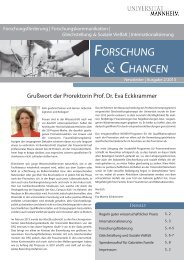
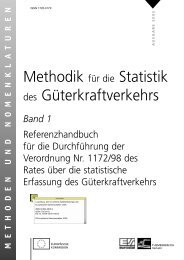

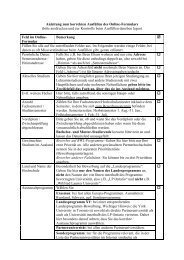


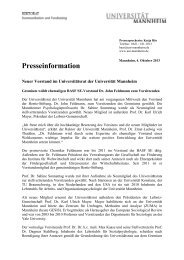


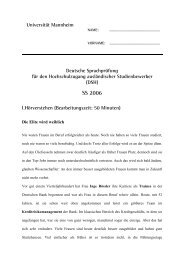
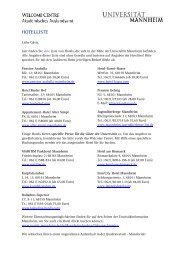
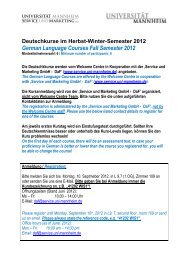
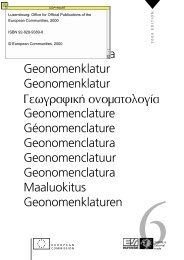
![226. [Augsburg], 27. Oktober 1562 An Joachim Camerarius d. Ã ...](https://img.yumpu.com/27559109/1/184x260/226-augsburg-27-oktober-1562-an-joachim-camerarius-d-a-.jpg?quality=85)